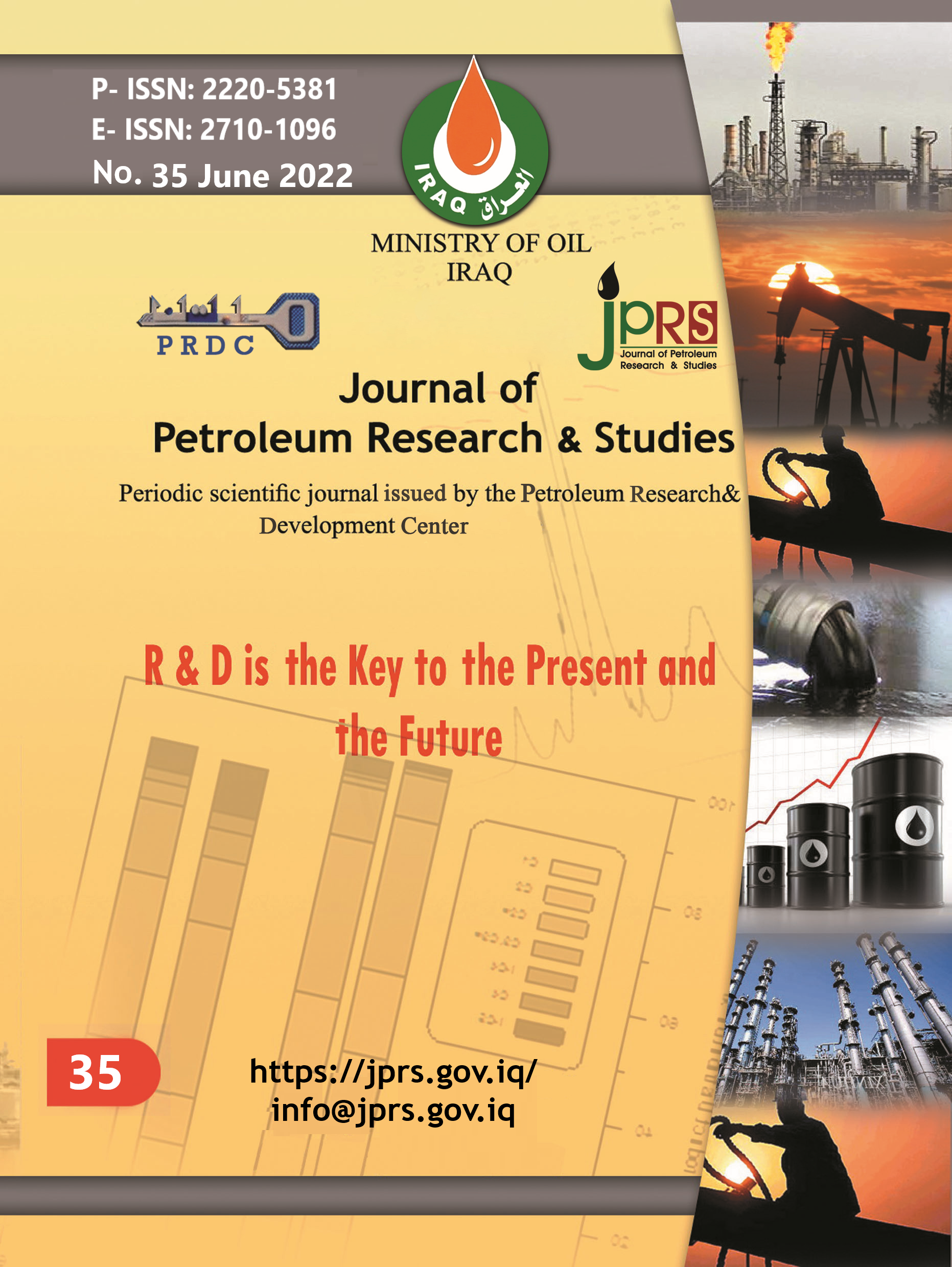Study The Effect of The Main Variables on The Objectives of The Natural Gas Dehydration Plant by ASPEN-HYSYS v8.8
DOI:
https://doi.org/10.52716/jprs.v12i2.657Keywords:
Natural gas; Dehydration process; Tri-ethylene glycol; ASPEN-HYSYS v8.8Abstract
In the NGD process, TEG dehydration is commonly employed to prevent corrosion and blockage of equipment, valves, and piping systems. TEG is frequently lost in the system during this procedure owing to vaporization and carryover. Therefore, it is necessary to study the affection of variables of the dehydration process the process was simulated with ASPEN-HYSYSV8.8 and the thermodynamic model was glycol-package; the process was validated by comparing the Plant results with the simulation results and demonstrating good acceptance. ASPEN-HYSYS conducted a sensitivity study to investigate the impact of variables on the main objectives. , as this study showed that not all of these variables have a strong effect, some of them have a weak effect, for example (wet gas pressure and same case of solvent pressure) and the rest of the variables have a strong effect on this process, so it must be taken into consideration by the station operators where this The changes were targeted because they are subject to change within the plant, and the highest value and the smallest value were taken according to the factory's parameters. As these variables are taken into account and the requisite improvements are made, the natural gas drying process will improve, and the dry gas requirements needed will improve, resulting in increased benefit.
References
e. d. Rahimpour, Investigating the performance of dehydration unit with Coldfinger technology in gas processing plant., iran: Journal of Natural Gas Science and Engineering, 12, 1-12., 2013.
Gandhidasan, Parametric analysis of natural gas dehydration by a triethylene glycol solution., Energy Sources, 25(3), 189-201., 2003.
S. S. M. Rohani, Natural Gas Dehydration Using Silicagel: Fabrication of Dehydration Unit., Doctoral dissertation, UMP, 2009.
e. d. Farag, Natural gas dehydration by desiccant materials., Alexandria Engineering Journal, 50(4), 431-439., 2011.
M. &. D. P. Netusil, Comparison of three methods for natural gas dehydration., Journal of natural gas chemistry, 20(5), 471-476., 2011.
A. &. D. M. Aleghafouri, Modeling and simulation of a pressure–temperature swing adsorption process for dehydration of natural gas., Adsorption, 24(1), 121-133., 2018.
K. H. M. &. D. L. Dalane, Subsea natural gas dehydration with membrane processes: Simulation and process optimization., Chemical Engineering Research and Design, 142, 257-267., 2019.
S. R. &. S. A. Shooshtari, Optimal operation of refrigeration oriented supersonic separators for natural gas dehydration via heterogeneous condensation., Applied Thermal Engineering, 139, 76-86., 2018.
J. M. &. M. R. N. Campbell, Gas conditioning and processing (Vol. 121)., Campbell Petroleum Series., 1974.
M. A. M. A. S. M. H. A. S. J. N. V. D. O. H. .. &. O. G. Khan, Optimizing Effective Absorption during Wet Natural Gas Dehydration by Tri Ethylene Glycol., Journal of Applied Chemistry, 2, 1-6., 2012.
Z. B. A. &. L. L. Y. Kamin, Simulation and optimization of the utilization of triethylene glycol in a natural gas dehydration process., Chemical Product and Process Modeling, 12(4)., 2017.
H. A. H. S. R. K. &. R. H. Ranjbar, Application of relative sensitivity function in parametric optimization of a tri-ethylene glycol dehydration plant., Journal of Natural Gas Science and Engineering, 25, 39-45., 2015.
M. R. S. M. &. S. M. Rahimpour, Improvement of natural gas dehydration performance by optimization of operating conditions: a case study in Sarkhun gas processing plant., Journal of Natural Gas Science and Engineering, 15, 118-126., 2013.
N. C. G. Jacob, Optimization of Triethylene Glycol (Teg) Dehydration in a natural gas processing plant., Int. J. Res. Eng. Res. Eng. Technol, 3(6), 346-350., 2014.
M. &. A. K. Stewart, Gas dehydration field manual., Gulf Professional Publishing., 2011.
A. M. A. R. A. D. N. &. H. R. Braek, Optimization of process parameters for glycol unit to mitigate the emission of BTEX/VOCs., Process Safety and Environmental Protection, 79(4), 218-232., 2001.
A. O. &. W. M. A. Oni, Methodology for the thermoeconomic and environmental assessment of crude oil distillation units., International Journal of Exergy, 16(4), 504-532., 2015.
F. M. R. J. S. &. d. J. V. H. Fabrega, Exergetic analysis of the refrigeration system in ethylene and propylene production process., Energy, 35(3), 1224-1231., 2011.
D. L. Christensen, Gas Dehydration, Thermodynamic simulation of the water/glycol mixture., Aalborg University Esbjerg, 1-15., 2009.
S. &. P. W. A. Mokhatab, Handbook of natural gas transmission and processing., Gulf professional publishing., 2012.
N. A. &. H. N. Darwish, Sensitivity analysis and faults diagnosis using artificial neural networks in natural gas TEG-dehydration plants., Chemical Engineering Journal, 137(2), 189-197., 2008.
V. N. H. M. W. &. B. J. Hernandez-Valencia, Design glycol units for maximum efficiency., In Proceedings of the Annual Convention-Gas Processors Association (pp. 310-310). Gas Processors Association., 1992.
Downloads
Published
How to Cite
Issue
Section
License
Copyright (c) 2022 Ali Sameer Ismail Al-Jammali

This work is licensed under a Creative Commons Attribution 4.0 International License.














